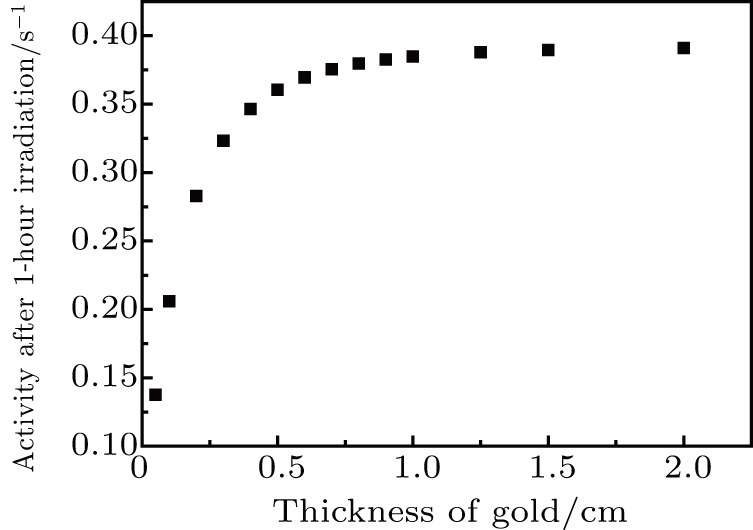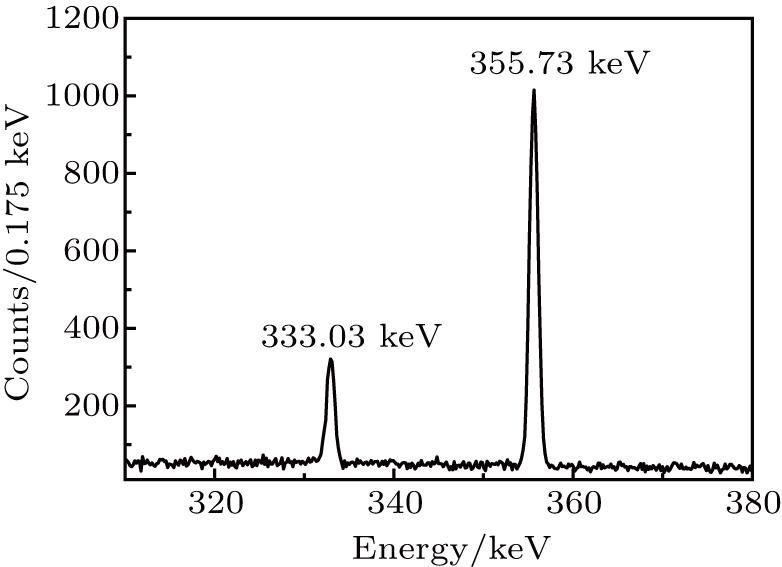† Corresponding author. E-mail:
High energy γ-ray can be used for nuclear waste transmutation by using the giant dipole resonance (GDR). The photonuclear reaction 197Au(γ, n) is known as a standard for studies on photoactivation experiments. The previous experiments on 197Au(γ, n) have been performed with bremsstrahlung, positron annihilation in flight or laser Compton scattering γ-ray. In this work, a new mono-energetic γ-ray source based on 13C(p, γ)14N reaction is used to measure the cross section of 197Au(
Development of nuclear power is the strategic choice for solving the energy supply and ensuring the sustainable development of economy and society. However, nuclear reactor of 1-GW power products about 30-tons spent fuel per year, including long-lived fission product (LLFP) about 30 kg.[1] In this situation, the disposal of LLFP becomes much important. The prime ways such as deeply bury, transport to the space, and ice cover are unable to ensure absolute safety which is the fundamental requirement of long-lived radioactive wastes disposal. In 1990s, Accelerator Driven Sub-critical System (ADS) was known as an effective method.[2] For most radioactive wastes, the neutron cross sections are high enough so the coupling efficiencies of transmutation are considerable. However, for some nuclei, the neutron cross section is very low and there may be some new radioactive nuclei generated during the transmutation of 137Cs. Another approach, photoneutron transmutation, due to the giant dipole resonance (GDR), may be a supplement of neutron transmutation, in which the largest cross section will be several hundreds millibarn in the high energy range.[3]
The high energy γ-ray is generated mainly by bremsstrahlung, positron annihilation in flight, laser Compton scattering, and nuclear excitation in nuclear reaction.[4] As a standard for studies on photonuclear reactions, 197Au(γ, n) has been investigated to verify the ability of transmutation perform with γ-ray. In previous studies, photonuclear experiments were performed mainly by using the γ-ray source of positron annihilation in flight.[5] The photoactivation experiment on 197Au was measured with bremsstrahlung facility on ELBE (electron linear accelerator of high brilliance and low emittance).[6] The photoneutron cross section of 197Au(γ, n) was measured with laser Compton scattering γ-ray at ring at AIST Tsukuba.[7] The nuclear transmutation rate on 197Au was measured on New SUBARU.[8] While the γ-rays from positron annihilation in flight, bremsstrahlung, and laser Compton scattering are not mono-energetic even continuous, so it is necessary to study the cross section or transmutation using mono-energetic γ-ray and compare the result with the measured values obtained with other methods.
Table
| Table 1.
Several resonance reactions. . |
According to the previous investigations, the reaction threshold of 197Au(γ, n) and 197Au(γ,2n) are 8.07 MeV and 14.7 MeV respectively.[9] So for the experiment of irradiation on 197Au by 9.17-MeV γ-rays generated from 13C(p, γ)14N reaction at Ep=1.75 MeV, only 197Au(γ, n) reaction can be taken place. There are two methods in measuring this reaction rate, i.e., by measuring neutrons during the reaction and by measuring γ-rays following the product. Considering the count rate of detector and the background during the irradiation, we decide to measure the γ-rays decay after the irradiation.
As the product of 197Au(γ, n) reaction, the unstable nucleus 196Au will decay to 196Pt (T1/2=6.18 d) by EC+

| Table 2.
Several γ-rays during the decay of 196Au and their emission probabilities. . |
In previous experiment about 13C(p, γ)14N at the 2×1.7-MV tandem accelerator in China Institute of Atomic Energy (CIAE), we had already determined the thick target yield and angular distribution of 9.17-MeV γ-ray.[10] The experimental setup of photoactivation experiment is shown in Fig.
Before the experiment, we should estimate the reaction rate for this experiment, so the thickness of gold target had to be chosen. Because of the attenuation of 355.73-keV γ-rays in the target, it makes no sense to set a very thick target. We estimated the activities after 1-hour irradiation, in which the yield of 9.17-MeV γ-rays was used 4.7×10−9 γ/proton in 4π, and the proton beam was 
 | Fig. 2. Calculation of the activities of targets with different thicknesses after 1-hour irradiation. |
In the experiment, the 8-


There exists absorption when γ-rays traversing through the gold target. The attenuation must be taken into account when measuring the number of 9.17-MeV γ-rays. We set a LaBr3 crystal detector in 
To gain the high statistics, two gold targets were irradiated by γ-rays for 21600 s and 19800 s, shelved for 12900 s and 11040 s respectively. We determine the cross section of 197Au(γ, n) by measureing 355.73-keV γ-rays from the product of 196Au. Figure
The absolute full-energy-peak detecting efficiency of HPGe detector for γ-ray of 355.73 keV was determined by measuring the 356.01-keV γ-ray decay from 133Ba source with the radioactivity of 1.07×105 Bq and the emission probability of 356.01-keV γ-ray is 0.621. Considering the emission probability of 355.73 keV from 196Au, we got the detecting efficiency, 
Our experimental setup is shown in Fig.
The total number of target nuclei in unit area Ns along θ direction can be written as
 |


 |






 |
 |
 |
Actually, the absorption of 355.73-keV γ-rays in gold target should be taken into account when determining the efficiency. And it is easy to see that the depth distribution of 196Au at axial direction in gold target is not uniform. So the attenuation coefficients of 355.73-keV γ-rays in different depths of the target are different. As the photoneutron reaction rate in different depths of the target can indicate the relative depth distribution of 196Au at axial direction, we can change the thickness of gold target and calculate the total attenuation coefficient. The total attenuation coefficient can be written as
 |

 |
 |
Finally, the efficiency was obtained to be 

 |

According to Eq. (
 |
 |
| Table 3.
Cross section of 197Au(γ, n) at 9.17 MeV along with the statistical ( |
The measurement of photoneutron cross section is important for studying the abilities of photonuclear transmutation in nuclear wastes disposal. We came up with a new method for measuring the cross section of photoneutron reaction based on a mono-energetic γ-ray source from (

| 1 | |
| 2 | |
| 3 | |
| 4 | |
| 5 | |
| 6 | |
| 7 | |
| 8 | |
| 9 | |
| 10 | |
| 11 |

















